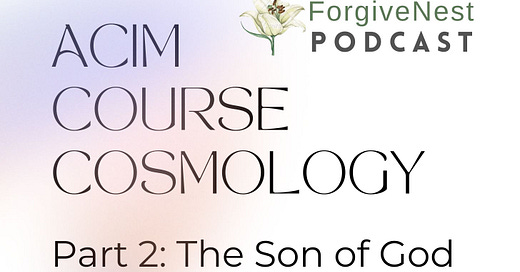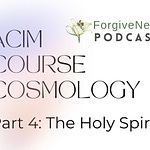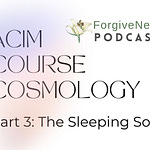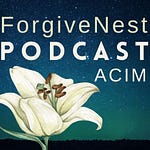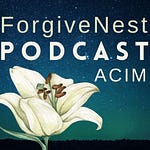Slideshow—Best viewed fullscreen or tablet
Transcript: ForgiveNest Podcast for A Course in Miracles, Part 2: ACIM ‘Course Cosmology’ Series, The Son of God - A Course in Miracles View on Christ, with Alison Anton
Previous in the ‘Course Cosmology’ Series:
Intro to ‘Course Cosmology’ — A Look at Resistance to Theism and Masculine Pronouns in A Course in Miracles
Hello and welcome back to Course Cosmology, Part 2: The Son of God. I'm Alison Anton with the ForgiveNest Podcast for A Course in Miracles. If you haven't yet watched part 1 on ‘God, Our Creator’, I recommend you watch that one first because I really designed the series to go consecutively to build off the previous slides.
God’s Son is Guiltless
So let's start off with what Jesus calls the central theme for A Course in Miracles and also for all forms of the "universal course", as he calls it, that leads us home to God.
He says:
"The course's central theme is always, 'God's Son is guiltless', and in his innocence is his salvation." [ACIM CE M-1.3:5]
Sometimes we don't see ourselves that way, but the Course's primary function is to help us see that way. Its purpose is to show us that our true nature is sinless and therefore guiltless.
The next passage is an affirmation to ourselves, about ourselves. I'll read it all the way through first, and then we'll repeat it together:
"I am the holy home of God himself. I am the Heaven where His love abides. I am His holy sinlessness itself, for in my purity abides His Own." [ACIM CE W-WI.14.1:3-6]
He's saying here in a roundabout way, that we have to be pure. God created us like Himself. If He is pure, so are we. And in our purity, abides His own.
So I'll read each line again for you to repeat to yourself as we go along:
I am the holy home of God himself.
I am the Heaven where His love abides.
I am His holy sinlessness itself,
for in my purity abides His own.
And we'll come back to the guiltless Son of God in a later slide, specifically the importance of recognizing each other as guiltless, which is the whole practice of A Course in Miracles.
So like we did in part 1, let's go through the list of what the Son of God is and what he is not.
First line says the son of God is Christ.
Christ is "…the perfect Son of God, His one creation and His happiness forever like Himself, and one with Him." [ACIM CE C-4.3:1]
Christ is the one Son in which we all are one with. Contrary to Christian thought, Christ is not limited to just Jesus. Jesus of A Course in Miracles doesn't say that he alone was the Christ. He says, we are the Christ. He is equal to us. But because he's come before us on the path back to God, in that sense, we can look upon him as a kind of “elder brother”, someone who's able to lead the blind. We're not blind permanently. Remember, we're sinless. But we do need the help that we can get here out of this dream.
Next line, the Son is one, but the Son is also infinite. The Course says:
"Creation is the sum of all God's thoughts, in number infinite, and everywhere without all limit." [ACIM CE W-WI.11.1:1]
Some students find this to be a paradox. How can you have one and many? But really it comes down to that our physical laws don't even come into play in true reality. It is a little like our quantum physics where scientists find things that behave in ways that don't follow logic. I think by now many of us can come to the basic terms of 'we are all and we are one'. From the Course perspective, one is everything.
And I put next to that, the Son can't be quantified. There's no quantity except infinite.
And next down, God's Son is innocent and guiltless. "I am his holy sinlessness himself", as we just recited on the previous slide. The Son of God isn't sinful. God doesn't see or know sin within us at all.
This leads us to think about the Christian "original sin". The Course does say we made a mistake—that we'll talk about in Part 3, ‘The Sleeping Son’—and even though this mistake had some pretty epic effects, the Course is saying there is no sin.
Next line: The Son is home in God and Heaven, not at home in a body on earth. Like we said in Part 1, God didn't create the world or the body, and therefore it's impossible for us as the Son to actually be home here.
Like our Creator, we as the Son of God, are eternal and timeless and we're also changeless and formless (just hitting these two bottom lines at once because they're similar concepts.) We're not in time or in a dimension; we only think we are. And we only identify with a body that is bound by being born and then dying.
Even if we have a loftier concept of life and death, like as in past lives and reincarnation, the concept of life and death in itself is part of a bigger lie so to speak about who we think we are. These ideas are extremely limiting in comparison to who we are as God created us. We are eternal, timeless, changeless and formless, and that will always be the truth of us according to the Course.
Every Part is the Container of the Whole
I wanted to come back to this symbol again, but a quick reminder here: I said in the last video that the flower of life symbol is not used in A Course in Miracles. I'm not teaching sacred geometry here. I just want to reiterate that the symbol itself is not a Course teaching, it's just something I use. We'll use the symbol each video in this series, adding onto it as we go, but this time, let's focus on the concept that the one is the whole. The whole of God is in each Son…
“…making every part container of the whole." [ACIM CE W-WI.11.3:2]
So God is the container of the Son, His creation; but we too, as the Son, are likewise the container of the whole. Remember last time we talked about a main tenet of the Course:
"Ideas leave not their source." [CE T-26.VII.4:6]
This line makes it clear that the Source never leaves its idea either. Ideas leave not their source, and the source leaves not its ideas. God is the container of us and we are the container of God.
The next passage reads:
"Without you, there would be a lack in God, a Heaven incomplete, a Son without a Father. For what God wills is whole and part of Him because His will is one." [ACIM CE T-24.VI.2:24]
Essentially, he's saying it's impossible for there to be a lack in God or the Kingdom. God willed for the Kingdom to be as one, which will eternally be one. What God wills is whole.
Looking at the symbol, can you start to see that the entirety of the Kingdom is contained by God, and that each Son also contains God within him, acting as the container for all?
Who Is the ‘You’ Jesus is Talking To in the Course?
A question that gets brought up a lot is: who is the "you" Jesus is referring to in the Course? He says "you" a lot. Is he talking to us as bodies and a brain? Is he talking to us as individual minds? Is he talking to our egos or is he communicating with our one Self as Christ? Who is ‘you’?
So we're back to that we are many Sons, and yet we are all one, as the Course glossary suggests:
"Although there are an infinite number of individual Sons, they all share a single universal Self: Christ." [ACIM CE Glossary-2.1:2]
Capital letters. When the Course uses a capital Y or capital S for You, Your or Self, it's talking about our single shared universal Self, the one Son, the "Us" that is Christ.
It's talking about our mind that hasn't thought of itself as split or separate; the part of us that has always remained in communication with God, and always will be.
Lowercase letters. When the Course uses a lowercase y or s for you and self, it's primarily talking to the "us" in this dream, the separated self or split mind that is asleep in a dream.
I call this the "sleeping Son". This specific term is used only a few times in the Course, with a lot of references to that we are asleep and in a dream.
So the lowercase ‘you’ or ‘self’ is still the Son of God, but it's a part of the Son's mind that's the dreamer of this dream.
It's not our bodies. The body is merely a stick figure in the dream. The sleeping Son is the part of us that makes decisions about which direction we should go in the dream.
The Course is primarily talking to the lowercase you because the decisions the dreamer chooses to make in the dream is what the entire Course is about; it's the lowercase us he's trying to reach and teach. Remember the whole part of us is whole, and it does not need healing, it does not need teaching, and it does not need learning. It has remained whole and will remain whole in Heaven, always. The part of us that needs teaching is the part of us that has chosen to perceive itself as split or as asleep in a dream.
So this is the ‘you’ that the Course is talking to.
Recognizing Our ‘Sameness’
Last slide we learned to recognize who Jesus is talking to: Who is the you that needs to learn this Course. This slide is about recognizing the sameness in each of us; recognizing not only that you are one of God's Sons, but also that all of us are.
This is one of the most important concepts of the Course. Let's go back to our beginning passage: "Its central theme is always, 'God's Son is guiltless', and in this innocence is his salvation." This innocence is our sameness.
No matter how we see each other in these bodies, the ultimate truth is that the person you're looking at still remains as God created him: guiltless, sinless and whole. It's only in this dream of separateness that he and you—and all of us—are acting out guilt, sin, fear, and hatred. Under all of that, we are all the same. We are as God created us.
And that's why forgiveness is the entire practice and premise of the Course as a whole. Forgiving each Son and the entire Sonship is the path. The Course quote below says that Jesus "saw the face of Christ in all his brothers and remembered God."
He remembered God by seeing the Christ in all his brothers, beyond their bodies; beyond their dream images.
"The name of Jesus is the name of one who was a man, but saw the face of Christ in all his brothers and remembered God. So he became identified with Christ, a man no longer, but at one with God." [ACIM CE C-4.2:1-2]
I just don't think I or any long-term Course practitioner could skirt around that the path is about seeing each of us as ultimately guiltless, and that the practice of forgiveness is what the Course says will lead us back home to God.
Workbook 351 says:
"My sinless brother is my guide to peace. My sinful brother is my guide to pain. And which I choose to see, I will behold." [ACIM CE W-351:1]
In the last slide, I talked about decisions, and this is it: what does the dreamer choose to see in everyone he looks upon? So that's why I started this video with "God's Son is Guiltless" and why I'm ending the video with "God's Son is Guiltless". Our brothers are our path out of pain. "I see the face of Christ in all my brothers, and I remember God."
Ending Passage from ACIM Workbook
I thought we could conclude this video with another passage from the workbook. This is from a section in Part II of the Workbook called, "What is the Christ", that talks about the innocent Self we share. (Self with a capital S.)
"Christ is God's Son as He created him. He is the Self we share, uniting us with one another and with God as well. He is the Thought Which still abides within the Mind that is His Source. He has not left His holy home, nor lost the innocence in which he was created. He abides unchanged forever in the Mind of God." [ACIM CE W-WI.6:1]
Up Next: Part 3, The Sleeping Son of God
And that concludes Part 2 of our 4-part ‘Course Cosmology’ series. Next up is The Sleeping Son, the part of our mind that chose to think of itself as separate from God; the one dreaming this dream we think we're in now.
Thanks for listening to the ForgiveNest Podcast, your place to explore ACIM topics in meditation, healing, and your special function in forgiveness.
I'm Alison Anton.
It was great talking to you.

